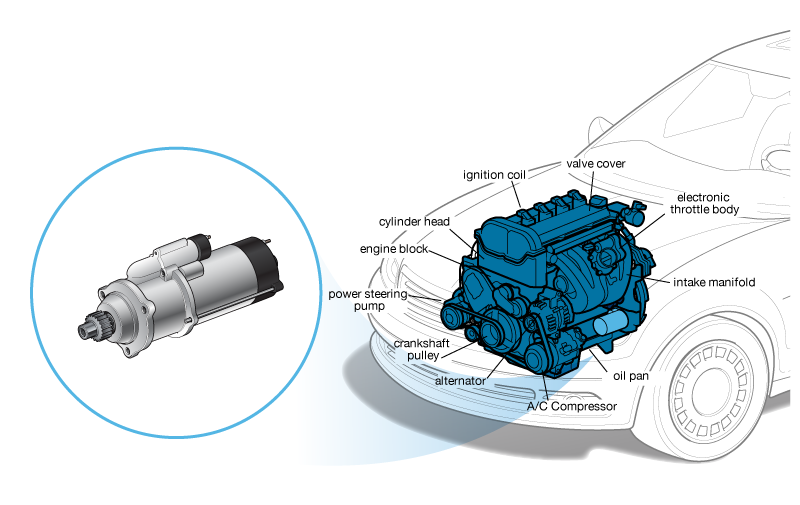Electrical & Lighting
Listen, repeat, memorize!
Starter
A starter (also self starter, self, cranking motor, or starter motor) is a device used to rotate (crank) an internal-combustion engine so as to initiate the engine’s operation under its own power.
Starters can be electric, pneumatic, or hydraulic. In the case of very large engines, the starter can even be another internal-combustion engine.
Internal-combustion engines are feedback systems, which, once started, rely on the inertia from each cycle to initiate the next cycle.
In a four-stroke engine, the third stroke releases energy from the fuel, powering the fourth (exhaust) stroke and also the first two (intake, compression) strokes of the next cycle, as well as powering the engine’s external load.
To start the first cycle at the beginning of any particular session, the first two strokes must be powered in some other way than from the engine itself.
The starter motor is used for this purpose and is not required once the engine starts running and its feedback loop becomes self-sustaining.
The starter is an electric motor that uses power from the battery to turn the flywheel and crankshaft and start the engine.
The crankshaft holds the connecting rods and pistons, so it requires a healthy starter motor and strong battery to move all that metal and get the engine going – a job that’s more difficult in cold weather because the engine oil is thicker.
Starters wear out and electrical connections can come loose or fail, but starter motors often last for the life of a vehicle.- Listen to the Text:
Door Window Motor
Listen, repeat, memorize!
Power windows are almost universal in modern vehicles, and if a window doesn’t go up and down, the electric motor that supplies the power could be at fault.
The window motor is mounted inside the door panel and attached to the regulator, the mechanical assembly that does the heavy lifting to raise and lower the window.
Power windows may not work for a variety of reasons, but one way to check if the motor is at fault without disassembling the door is to activate the power window switch.
If you don’t hear anything, the motor or switch is probably bad. If the window raises and lowers slowly, the motor could be worn or the window tracks could be gummed up.
If you can hear the motor but the window doesn’t move, the fault could be in the regulator, damaged wiring or a bad control module.
Other possible causes to check before deciding you need a new window motor include the fuse or relay for the power windows, but if either of those has blown none of the windows will work.
Motors aren’t usually that expensive to replace, but as with other repairs the labor time can greatly add to the cost because the door panel needs to be removed and the power window hardware removed.
Listen to the Text:- Check Engine Light Diagnosis

Listen, repeat, memorize!
The “Check Engine” light warns drivers that something is wrong, and occurs when the computer issues an error message.
A solid light means that the issue is not urgent. A flashing light means stop immediately, as soon as it’s safe to stop.
You’re driving along in your car or truck and suddenly a yellow light illuminates on your dash telling you to check or service your engine.
If you’re like most car owners, you have little idea about what that light is trying to tell you or exactly how you should react.
Call it the most misunderstood indicator on your dashboard, the “check engine” light can mean many different things, from a loose gas cap to a seriously misfiring engine.
Ignore the warning, and you could end up damaging expensive components.
It also can be a sign that your car is getting poor fuel economy and emitting higher levels of pollutants.
The “check engine” light is part of your car’s so-called onboard diagnostics (OBD) system.
Computers increasingly have controlled and monitored vehicle performance, regulating such variables as engine speed (RPM), fuel mixture, and ignition timing.
In some cars, the computer also tells the automatic transmission when to shift.
Listen to the Text:- Battery Replacement

Listen, repeat, memorize!
If you own or lease a vehicle for more than three years, at some point you’ll have to replace the battery.
Over time, a battery’s capacity to store electricity will diminish, or it will suffer physical damage such as a cracked case.
How soon a battery needs replacing depends on a number of factors, such as the number of times it’s used to start the engine.
Where it lives is also a factor; although battery failure is most often associated with cold weather, hot temperatures do more to shorten battery life by evaporating the fluid and destroying cells inside the battery.
Batteries frequently get blamed for all sorts of electrical issues, but they’re only one part of a car’s charging system.
Batteries store the electrical power that starts the engine and operates accessories, such as the lights, power locks and windows, and the stereo.
The battery depends on the alternator to generate electricity and a voltage regulator to control the amount of electricity generated.
If either of those components becomes worn or fails, the battery won’t be fully charged and able to do its part.
That’s why it pays it have the entire charging system checked before replacing a battery to make sure the problem isn’t somewhere else.
Many parts stores (as well as repair shops) will check a battery’s state of charge and reserve capacity for free, but just replacing the battery won’t fix problems caused by the alternator, voltage regulator, or damaged electrical connectors or cables, or if the belt that drives the alternator is loose or worn.
Listen to the Text:
